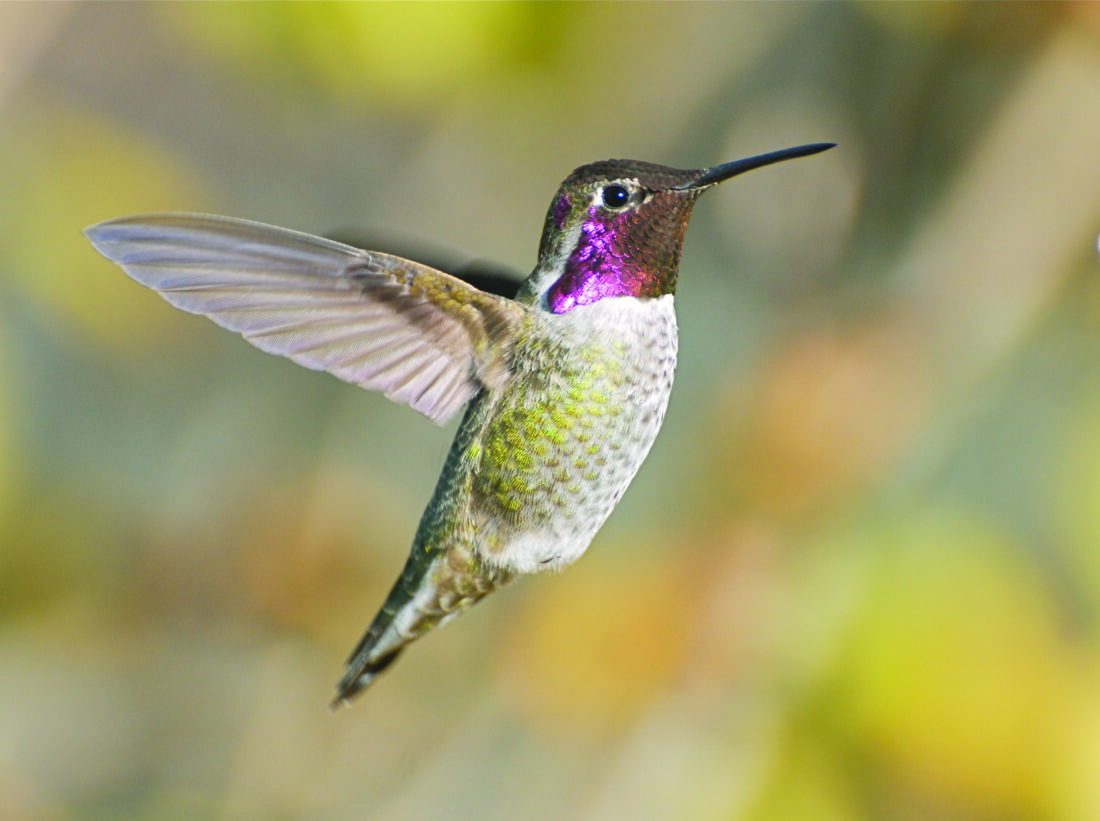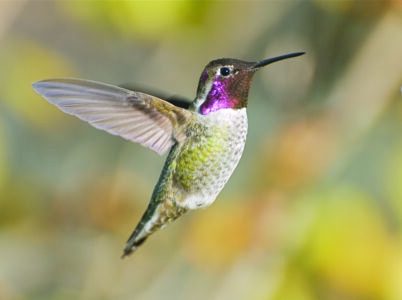What’s Flying: Just a bit like going to heaven

An Anna's hummingbird looks on. (Scot Stewart photo)
“I hope you love birds too. It’s economical. It saves going to heaven.” – Emily Dickinson
Poets find an elegant way to speak of truths, full of economy and succinctness. Birds have long been a source of admiration, appreciation for nature, and love of life. Birds provide the music of our mornings, the color of our winters, and the companionship of a lifetime. August reminds the Upper Peninsula signs of Autumn are in the offing. A trip past a large wetland lined with red maples is sure to show signs of them beginning to turn colors. Those smaller maples are usually a dark, subtle shade of vermillion. More goldenrods are beginning to bloom along roadsides adding even more touches of yellow to the edges.
Bird migration is also picking up and some signs have been in locations that might be cause for surprise. Mitigation ponds, small wetland created to compensate for those lost to development of roads, parking lots, and new construction are becoming attractive areas for migrating birds and some resident birds. In Marquette the mitigation ponds at Presque Isle have hosted a number of nesting waterbirds during the summer, and migrants have included Virginia rails, horned grebes, and a harlequin duck. In late summers black-billed cuckoos sometimes appear as they did last week.
The mitigation pond near the intersection of Wright Street and Lakeshore Blvd. in Marquette is another good place to look for ducks and herons. Great blue herons fish there from time to time throughout the summer and mallards are often there too. During spring migration northern shovelers, blue-winged teals and other dabbling ducks are sometimes found there.
The mitigation pond near a large store on the north side of Escanaba has found some bird diversity again this week with American black ducks, spotted and least sandpipers making stops this past week. The ponds also attract a wide array of shorebirds during migrations as well as great blue herons and great egrets.

SCOT STEWART
Birding on the points of land in the U.P close to the Great Lakes can be great in August. At Portage Point south of Escanaba last Saturday, August 2, a day of birding yielded a number of terrific birds. An eastern towhee, blue-gray gnatcatcher, and a yellow-throated vireo were all found. The towhee is an unusual summer resident in the U.P., but the other two are more commonly found to the south in Wisconsin.
August is a great time of year to begin looking for wandering birds not normally found in the area. Another great egret turned up in the Marquette area this past week, hunting in the Chocolay Bayou this past Monday. It is not unusual for large wading birds like egrets and herons to wander out of their normal range. With the
- An Anna’s hummingbird looks on. (Scot Stewart photo)
- SCOT STEWART
Late summer and fall are also good times to see hummingbirds and flycatchers from outside the area too. Mexican violetears, berylline, Anna’s, and rufous hummingbirds are not normally found in the Eastern U.S. The normal ranges for Mexican violetears and berylline are south of the border, so their presence here in the U.P. is quite remarkable. Their wandering this far south is not easy to explain.
Both have been seen in Alger County. Anna’s and rufous are occasional visitors, usually during fall migration when they may be blown off course by storms as they head south. A pair of Anna’s spent a month and a half in Grand Marais in November and December 2010. Anna’s hummingbirds are the hardiest of them wintering along the milder Pacific Coast all the way to Alaska.
Flycatchers are delightful surprises in late summer and fall too. Notable sightings of all of them are due in large part to distinctive physical characteristics. Western kingbirds and their three western kingbird relatives, tropical, Cassin’s, and Couch’s all have the shape of the local eastern kingbirds but have noticeable yellow breasts. Because of the similar appearances, they are all best identified by their calls.
The two most easily noticed and identified are flycatchers with long tail feathers. Male scissor-tailed and fork-tailed flycatchers have 12-inch and 18-inch tails respectively. The former is more commonly seen here probably because of the closer proximity of their normal summer range in parts of Missouri and Kansas. Their peach-colored sides and under-wings make them real standouts. Fork-tailed flycatchers are unmistakable. One was first located by a birder just north of Menominee as it flew across M-35 in 2016. Fortunately, it stuck around for several days alternating between insects it found and dogwood berries in a stand of bushes growing along the road. Because of some good weather and the find close to the weekend, a huge number of both Wisconsin and U.P. birders were able to drive over and see this amazing bird.
For the flycatchers, some may be sent in the wrong direction by storms and the jet stream but is thought a number of birds may get their navigation system with its internal compasses in their brains turned around sending them northward instead of to the south. Birders are encouraged to snap a picture or two, or even a video of birds they believe could be unusual to help with identification. There are plenty of unusual and exciting birds around during the late summer months! Seeing some of the season’s guests and residents is just a bit like going to heaven.


